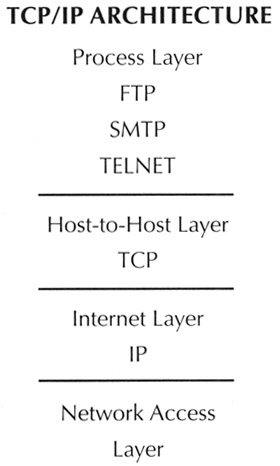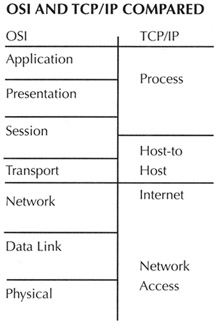Section IV: Network and Transport Layer Protocols
| |
The TCP/IP Protocol Suite
Just about everyone in the networking industry talks about interoperability; the U.S. Department of Defense (DOD), in the guise of the ARPANET (Advanced Research Projects Agency Network) project, actually did something about it when it created the Transmission Control Protocol/Internet Protocol (TCP/IP) family of networking protocols.
TCP/IP is the DOD's answer to connecting its rapidly proliferatingand widely dissimilarcomputers and networks into a loosely associated wide area network (now called the Internet). TCP/IP is the DOD's vehicle for providing distributed computing capabilities across a large area.
TCP/IP might also be called the less talented but still much in demand ugly stepsister to the International Standards Organization's (ISO) Open System Interconnection (OSI) protocols. Though the OSI protocols were designed to dominate the computer environment, TCP/IP remains the central piece in the complex interoperability puzzle.
A Plenitude Of Protocols
As its two-part name implies, TCP/IP encompasses more than one protocol. It includes a range of protocols that provide distinct services and capabilities necessary for communication between and control of otherwise incompatible computers and networks. In addition to the Transmission Control Protocol (TCP) and Internet Protocol (IP), these include the File Transfer Protocol (FTP), the Simple Mail Transfer Protocol (SMTP), the Internet Control Message Protocol (ICMP), and the Simple Network Management Protocol (SNMP).
Other protocols within the TCP/IP family are the Address Resolution Protocol (ARP), the Reverse Address Resolution Protocol (RARP), the Exterior Gateway Protocol (EGP), and the User Datagram Protocol (UDP). IP, TCP, FTP, SMTP, and Telnet were part of the original DOD military standard, TCP/IP protocol suite promulgated in the late 1970s. Although TCP/IP was the brainchild of and for the military, it has become the de facto protocol for general-purpose intersystem communication.
The TCP/IP Framework
The body of standards making up the TCP/IP suite fit within a four-layer (network access, internet, host-to-host, and process layers) communications framework, shown in Figure 1. Before examining these layers individually, however, it's important to first understand several other concepts.

Figure 1: The TCP/IP body fits within a four-layer framework.
The DOD based its model of data communication on three agents , called processes, hosts, and networks, with processes as the fundamental communications entities. Processes are executed on hosts , which are internetworked computers that can generally support multiple processes. Hosts in turn communicate with each other via a network. Successful completion of an operation on the internet requires action by all three agents.
The transfer of data from one process to another requires first getting the data to the host in which the process resides, then to the process within the host. In this model, a communications facility must be concerned only with routing data between hosts, with the hosts concerned with directing data to processes.
The network-access layer handles the exchange of data among a host, the network that host is attached to, and a host within the same network. The sending host provides the network with the network address of the receiving host to ensure that the network routes the data properly. The TCP/IP network-access layer services correspond to those provided by the physical, data-link, and parts of the network layers in the OSI reference model (see Figure 2).

Figure 2: The TCP/IP network-access layer services correspond to those provided by the physical, data-link, and parts of the network layers in the OSI reference model.
The specific physical, or media-access, protocol used to put TCP/IP data on the wire is independent of TCP/IP's top three layers. This means that TCP/IP can operate over virtually any media-access protocol, including Ethernet, Token Ring, or FDDI.
The separation of the physical-layer functions from the higher layers also means that the services provided by the internet, host-to-host, and process layers are not affected by the specifics of the underlying network protocol used. The same high-level software can function properly regardless of the network type a host is connected to.
The internet layer provides services that permit data to traverse hosts residing on multiple networks. The internet routing protocol runs not only on "local" hosts, but also on gateways that connect two networks. A gateway's primary responsibility is to relay data from one network to the other, making sure it gets to the appropriate destination host.
The host-to-host layer ensures the reliability of the data and between two TCP/IP hosts. And the process layer provides protocols needed to support various end-user applications, such as file transfer or electronic mail.
The TCP/IP Protocols
Each TCP/IP protocol provides a specific service or set of services to move data from one computer to network to computer. The services some of these providethe File Transfer Protocol (FTP), for instanceare self-explanatory. Others aren't so obvious.
In the lexicon of the TCP/IP world, an interconnected set of networks is called an internet; the Internet Protocol (IP) is responsible for accepting segmented data (in the form of a Protocol Data Unit, or PDU) from a host computer and sending it across the Internet through the required gateways until the data reaches its destination.
The IP delivery process provides what is known as an unreliable connectionless service; proper delivery is not guaranteed by IP. Even PDUs that are delivered may arrive at the destinations out of sequence. TCP must ensure reliable delivery of PDUs. TCP provides the transport mechanism that ensure that data is delivered error-free, in the order it was sent, and without loss or duplication.
TCP's basic role is providing reliable end-to-end data transfer between two processes, called transport users (these include FTP and SMTP). In specific terms, the TCP standard describes five levels of service: multiplexing (the ability to support multiple processes), connection management, data transport, error reporting, and a variety of special capabilities.
In the basic data-transfer process, a transport user such as FTP passes data to TCP, which encapsulates the data into a segment that contains user data and control information (e.g., the destination address). TCP ensures reliable data delivery by numbering outgoing segments sequentially and then having the destination TCP module acknowledge arrival by number. If segments arrive out of order, they can be reordered via sequence numbers , and if a segment fails to arrive, the destination TCP module will not acknowledge its receipt, and the sending TCP module resends it.
TCP allows the transport user to specify the quality of transmission service it requires, permits special urgent data transmissions, and provides security classifications that can be used in routing segments to data-encryption devices. In trying to provide high-quality transmission services, TCP attempts to optimize the underlying IP and network resources. Parameters available include timeout delays and message-delivery precedence. Interrupt-driven urgent transmissions include terminal-generated break characters and alarm conditions.
The services provided by TCP and IP are defined by primitives and parameters. A primitive is a mechanism for specifying the function to be performed, while parameters are used to pass data and control information.
Only two primitivesSEND and DELIVERare used to define the IP services. Parameters available with these primitives include source and destination host addresses, the recipient protocol (usually TCP), an identifier that distinguishes one user's data from another's, and user data.
TCP offers two primitives and associated parameters: service request and service response primitives. A TCP client sends service request primitives to TCP; TCP issues the service response primitives to the client. Many of these primitives set off an exchange of TCP segments between host processes or computers, and TCP passes the segments to IP in a SEND primitive and receives them from IP in a DELIVER primitive.
Files And Terminals
FTP exists to transfer a file or a portion of a file from one system to another under orders from an FTP user. Typically, a user executes FTP interactively through an operating system interface, which provides the input/output facilities that allow exchanging files between systems.
FTP options allow transferring ASCII and EBCDIC character sets and using transparent bit streams that permit exchanging any sort of data or text file. FTP also provides data-compression options and has password/identifier mechanisms for controlling user access.
SMTP provides the underlying capabilities for a network electronic mail facility. It does not, however, provide the user interface. Primarily, it provides mechanisms for transferring messages between separate systems. SMTP accepts e-mail messages prepared by a native mail facility (such as cc:Mail) andmaking use of TCP to send and receive messages across the network delivers them.
With SMTP, users can send mail to users anywhere in the local network as well as to those on the Internet.
TELNET outlines a network terminal-emulation standard. It allows terminals to connect to and control applications running in a remote host just as if it were a local user of the host.
In implementation, TELNET takes two forms: user and server modules. The user module interacts with the terminal I/O module, providing translation of terminal characteristics into the network-specific codes and vice versa. The server module interacts with processes and applications, serving as a terminal handler to make remote terminals look as if they are local.
SNMP And Other Protocols
Among the other TCP/IP protocols, one of the most widely applied is SNMP, the Simple Network Management Protocol. SNMP supports the exchange of network management messages among hosts, including a central host that is often called a network management console.
SNMP was designed to operate over UDP, the User Datagram Protocol. UDP operates at the same level as TCP, providing a connectionless service for the exchange of messages while avoiding the overhead of TCP's reliability facilities.
ARP and RARP provide mechanisms for hosts to learn MAC and Internet addresses. The former allows a host to discover another host's MAC address, and the latter permits a host to find out its own Internet address, an important capability for diskless PCs without permanent ways to store their Internet addresses.
The Exterior Gateway Protocol allows neighboring gateways in different autonomous systems to exchange information about which networks are accessible via a particular gateway. Industry observers once predicted that most TCP/IP users would eventually migrate to OSI. The question is, when? Few commercially available products offer complete OSI functionality. Most OSI protocols remain in the standards-setting phase, and users continue to be satisfied with the level of service provided by TCP/IP.
This tutorial, number 28, by Jim Carr, was originally published in the November 1990 issue of LAN Magazine/Network Magazine.
| |
EAN: 2147483647
Pages: 193